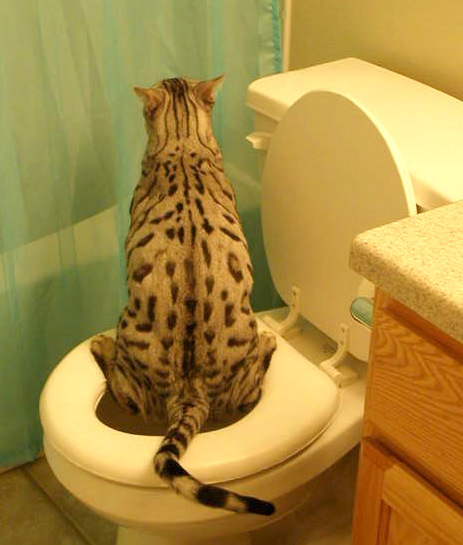We have stumbled upon the article relating to How to Dispose of Cat Poop and Litter Without Plastic Bags below on the net and decided it made sense to relate it with you on this site.

Introduction
As feline proprietors, it's important to be mindful of exactly how we deal with our feline friends' waste. While it might seem practical to flush feline poop down the toilet, this method can have detrimental repercussions for both the environment and human health and wellness.
Environmental Impact
Flushing feline poop presents hazardous virus and parasites right into the water supply, presenting a significant danger to aquatic environments. These contaminants can adversely impact aquatic life and compromise water high quality.
Wellness Risks
In addition to ecological issues, flushing feline waste can also posture health risks to people. Pet cat feces may contain Toxoplasma gondii, a bloodsucker that can cause toxoplasmosis-- a possibly serious illness, especially for expectant ladies and individuals with weakened body immune systems.
Alternatives to Flushing
Fortunately, there are much safer and extra liable ways to take care of cat poop. Think about the adhering to alternatives:
1. Scoop and Dispose in Trash
One of the most usual method of throwing away pet cat poop is to scoop it right into a biodegradable bag and throw it in the trash. Make sure to utilize a committed clutter inside story and throw away the waste without delay.
2. Use Biodegradable Litter
Select eco-friendly pet cat litter made from materials such as corn or wheat. These litters are eco-friendly and can be safely gotten rid of in the trash.
3. Bury in the Yard
If you have a yard, think about burying feline waste in a marked location far from vegetable gardens and water sources. Be sure to dig deep sufficient to avoid contamination of groundwater.
4. Set Up a Pet Waste Disposal System
Invest in an animal waste disposal system specifically made for pet cat waste. These systems utilize enzymes to break down the waste, minimizing odor and environmental impact.
Verdict
Accountable animal ownership extends past supplying food and shelter-- it also entails appropriate waste management. By avoiding purging cat poop down the toilet and going with alternate disposal techniques, we can minimize our ecological impact and secure human health and wellness.
Why Can’t I Flush Cat Poop?
It Spreads a Parasite
Cats are frequently infected with a parasite called toxoplasma gondii. The parasite causes an infection called toxoplasmosis. It is usually harmless to cats. The parasite only uses cat poop as a host for its eggs. Otherwise, the cat’s immune system usually keeps the infection at low enough levels to maintain its own health. But it does not stop the develop of eggs. These eggs are tiny and surprisingly tough. They may survive for a year before they begin to grow. But that’s the problem.
Our wastewater system is not designed to deal with toxoplasmosis eggs. Instead, most eggs will flush from your toilet into sewers and wastewater management plants. After the sewage is treated for many other harmful things in it, it is typically released into local rivers, lakes, or oceans. Here, the toxoplasmosis eggs can find new hosts, including starfish, crabs, otters, and many other wildlife. For many, this is a significant risk to their health. Toxoplasmosis can also end up infecting water sources that are important for agriculture, which means our deer, pigs, and sheep can get infected too.
Is There Risk to Humans?
There can be a risk to human life from flushing cat poop down the toilet. If you do so, the parasites from your cat’s poop can end up in shellfish, game animals, or livestock. If this meat is then served raw or undercooked, the people who eat it can get sick.
In fact, according to the CDC, 40 million people in the United States are infected with toxoplasma gondii. They get it from exposure to infected seafood, or from some kind of cat poop contamination, like drinking from a stream that is contaminated or touching anything that has come into contact with cat poop. That includes just cleaning a cat litter box.
Most people who get infected with these parasites will not develop any symptoms. However, for pregnant women or for those with compromised immune systems, the parasite can cause severe health problems.
How to Handle Cat Poop
The best way to handle cat poop is actually to clean the box more often. The eggs that the parasite sheds will not become active until one to five days after the cat poops. That means that if you clean daily, you’re much less likely to come into direct contact with infectious eggs.
That said, always dispose of cat poop in the garbage and not down the toilet. Wash your hands before and after you clean the litter box, and bring the bag of poop right outside to your garbage bins.
https://trenchlesssolutionsusa.com/why-cant-i-flush-cat-poop/

I was made aware of that report about Can You Flush Cat Poop Down The Toilet? from someone on another web blog. Do you know somebody else who is occupied with Can You Flush Cat Poo or Litter Down the Toilet?? Why not promote it. I am grateful for your time. Don't hesitate to check our site back soon.
Call Today
Comments on “The Dangers of Flushing Cat Poop Down Your Toilet - Tips for Safer Disposal”